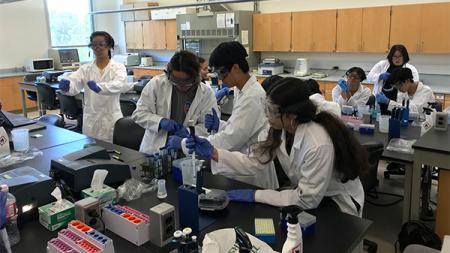KURE Summer Bridge Program
The KURE Summer Bridge Program (SBP) is an 8 week summer research training program providing research experiences in a variety of disciplines including biomedicine, environmental science, materials science, geology, data science or chemistry.
This program is for high school students who are planning to enroll in a science or math major at CSULB or 1st- or 2nd-year students majoring in science or math at CSULB or accepted incoming transfer students who are enrolled in a science or math major at CSULB. Participating students will first complete one week of general laboratory training and then be placed in faculty research labs according to their self-identified interests.
The application period for this cycle is now closed.
Questions regarding this program should be directed to Dr. Yuan Yu Lee: YuanYu.Lee@csulb.edu.
Program Details
Participating students will participate in one week of safety and research skills training. This will include conducting research on environmental toxins that are common in household items or products. For weeks 2-8 students will be matched with a host lab at CSULB where they will complete their internship in their discipline of interest.
Dates
June 23, 2025 - August 15, 2025.
Timeline
Participants will work in the lab 3-5 days/week and receive up to 20 hours per week or $3,200 for their 8 weeks of research. Note: the 3-5 weekdays of research will vary from week to week, so we can accommodate the Independence Day holiday.
A brief overview of each week’s activities is given in the table below.
| Week | Days | Toxin | Research Tasks |
|---|---|---|---|
| 1 | 6/23 | n/a |
|
| 1 | 6/24 | BPA |
|
| 1 | 6/25 | BPA |
|
| 1 | 6/26 | multiple toxins |
|
| 1 | 6/27 | multiple toxins | final presentation |
| 2-8 | 6/30 to 8/15 | n/a | dependant on lab PI |
What are BPA and TCS?
Bisphenol A (BPA) and triclosan (TCS) are pervasive environmental toxins with human impacts that raise concerns. BPA, commonly found in plastics, epoxy resins, and thermal paper, leaches into food and water, exposing humans through ingestion and skin contact. Triclosan, an antimicrobial agent, is common in personal care products like soaps, toothpaste, and cosmetics, along with household items like plastics and textiles.
Both chemicals disrupt endocrine function by mimicking or blocking hormones. Endocrine disruption can lead to developmental abnormalities, reproductive issues, and increased risk of certain cancers. These toxins also persist in the environment, accumulating in ecosystems and potentially posing long-term risks to wildlife and ecosystems. Effective regulation and consumer awareness are crucial to reducing adverse effects of BPA and triclosan.
Program Goal
The goal of the program is to provide you with an understanding and appreciation for research, and to nurture your interest in science and math degrees and careers.
Project Objectives
- To increase your ability to apply concepts and skills learned in the classroom to research.
- To increase your understanding of the research process; that science is a creative process that creates new knowledge.
- To increase your knowledge of ethical conduct in your field.
- To increase your ability to interpret results in research and draw conclusions.
Benefits

- Hands-on research experience
- Gain an awareness of environmental toxins—where they are; where they come from; and how they affect human health.
- Professional and research career development.
- Up to $3,200 salary while participating in the program.
Eligibility Requirements
- U.S. Permanent Resident or U.S. Citizen
- Available during program dates
- Meets one of the following situations:
- high school student who is planning to enroll in a science or math major at CSULB
- 1st- or 2nd-year student majoring in science or math at CSULB
- CNSM transfer student (Fall 2025 transfer cohort)
Application Requirements
Your Application Packet MUST include:
- KURE Summer Bridge Program Online Application.
- Personal Statement (5 paragraph essay, 2 page maximum) addressing the following:
- Paragraph 1: Introduce yourself and share the top 3 reasons/motivations driving your interest in science research.
- Paragraph 2: Describe your short- and long-term career goals.
- Paragraph 3: Explain how the KURE Summer Bridge Program will help you reach these goals.
- Paragraph 4: Discuss your academic struggles or challenges and how you overcame them.
- Paragraph 5: Conclude with a summary of the previous paragraphs, adding anything else about you and your potential as a research scholar.
- 1- to 2-page Resume.
- Unofficial transcripts from previous institution(s).
- Application is due on or before May 19, 2025 by midnight.
Review your Application CAREFULLY! You must honor ALL requirements and deadlines to be considered for the program.
Participation is limited, so selection will be competitive. You are encouraged to gather all your application materials early and submit your application as soon as possible.





